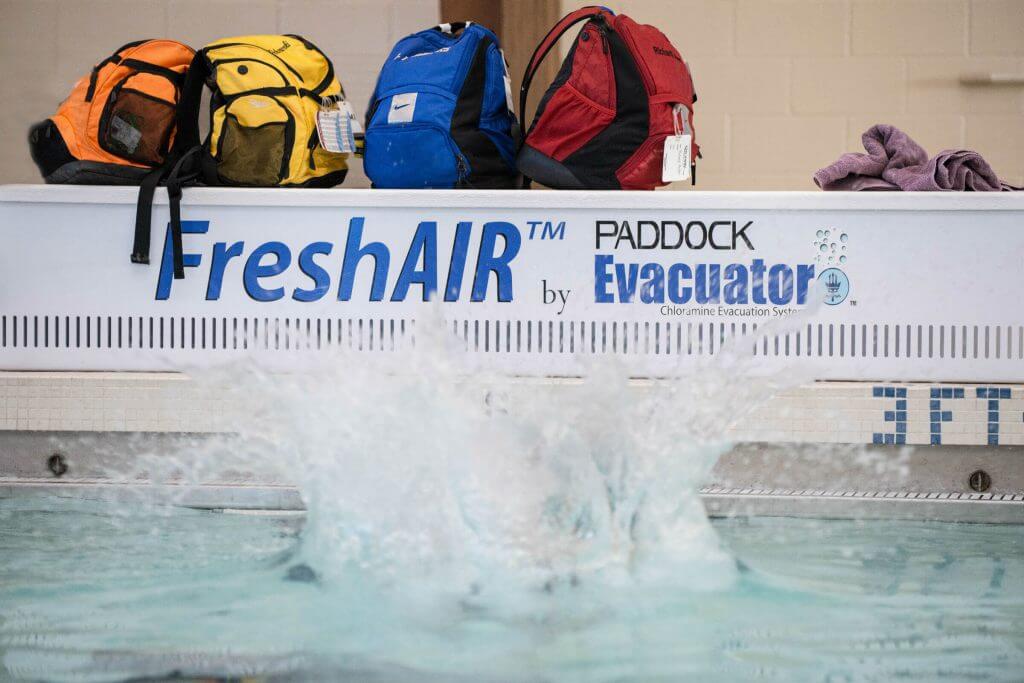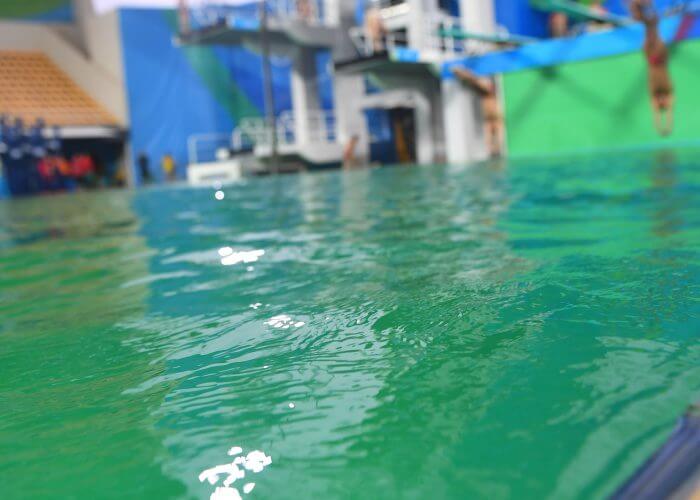A Second Look at the Air Quality Issue

By Caitlin Daday, Swimming World College Intern
YMCA Nationals, April 2014. The Greensboro Aquatic Center has seemingly been completely transformed. Finally everyone could make it through the five day meet and still be able to breathe.
After sending swimmers to the hospital multiple years in a row, Greensboro underwent some big changes. At the time of the Winter Junior Nationals in 2013, they were only about halfway done. But by the next spring, when YMCA Nationals arrived, they were fully prepared to tackle another championship meet.
In building pools, most engineers do not have the experience or knowledge needed to install a system that will prevent air quality issues. And even if they do have that knowledge, there is not one magic bullet that will cure everything, says Mark Weber, a former swimmer who now works for Paddock Evacuator after suffering for many years in pools with bad air.
The common misconception, Weber says, is that water quality cures everything. In fact, it is only one piece of the puzzle.
“What it comes down to is that even if you have perfect water quality, if you dump 1,000 kids into a pool you’re going to have problems,” Weber says.
Facilities also need pool specific AC units that are specially designed to handle dehumidification, Weber says. Even still, dehumidification systems are only designed to heat, cool, and dehumidify air–they are not intended to separate good and bad air.
Dehumidifiers recycle air in the room, so bad air still gets mixed back in. Instead, the bad air needs to be removed and replaced with fresh air.
This brings us to source capture systems. In facilities with source capture systems, all the bad air is swept into the system so that the HVAC system is only putting good air back into the the room. Source capture systems get as close to the water as possible, such as in gutters, in order to most effectively sweep up all the bad air and get it out.
Still, Weber says that source capture is not going to solve the problem by itself. Water quality is still very important, as is having a secondary disinfectant, such as a UV system.
All three pieces–source capture, water quality, and a secondary disinfectant–need to be working in tandem to get results like Greensboro did. Even then, when one little thing gets tweaked, big problems can ensue. Basically everything has to be just right.
Further, chloramines do not just cause problems to the air but also harm the physical structures of facilities. Chloramines in the air cause rust, which in turn damages the metal around the pool. HVAC systems are among the victims of this damage.
“If you’re running an HVAC system with chloramines through it, it’s like chain smoking,” Weber says. “You don’t know when it’s going to kill you, but it will.”
In other words, chloramines can cause the HVAC system enough damage that it will eventually break down. If that happens, the air problems will only get worse. As such, source capture systems and secondary disinfectants are needed to keep the number of chloramines in the air under control so they are not traveling through the HVAC system.
So the fix to the problem is not that difficult then. Install a source capture system and a secondary disinfectant, and tell people to shower off before swimming and stop peeing in the pool. With that you should be good to go, right?
Unfortunately it is not that easy. These systems are not exactly cheap. As a result, many facilities are unable to afford the systems necessary to cure all their ills.
To these pools and their managers, Weber says that consistent facility maintenance is very important. Insuring that the chemicals are good and that the chlorine is kept pretty low will help to some extent.
Rinsing off and getting swimmers to stop peeing in the pool is not a solution, but it will help, Weber adds. He further recommends that facilities managers watch what they clean the pool deck with and encourage people not to wear street shoes on deck. Cleaning chemicals, such as ammonia, and dirt from shoes can add even more chloramines to the air if it hits chlorinated water. On the contrary, opening doors overloads the HVAC system and only makes the problems worse.
These are all just little things to keep in mind when monitoring air quality issues; they will not be able to solve the problem in its entirety. However, if a facility cannot afford source capture or a secondary disinfectant, they can be helpful.
Greensboro was fortunate enough to have the means to install not one but three source capture systems. Because of their good reputation for hosting championship meets, they wanted to bring in the best, facility manager Susan Braman says.
“We’ve hosted many championships since 2013 and have not had any problems,” Braman says. “We have people calling every day to find out what we did.”
The main thing Greensboro did was rework their HVAC system and install the three source capture systems. Once those changes were made, their air was pristine.
Braman says that aquatic centers need to enforce showering before entering the pool. While it is difficult to prevent peeing in the pool, coaches and others on deck can control showering. Rinsing off is a cost-free starting point to improving air quality.
“At the end of the day, people just want to be able to go swim and be able to breathe,” Weber says. Facilities all across the country, such as the Greensboro Aquatic Center, are doing the best they can to provide the athletes competing in their pools with the highest quality air possible. While the best current solution remains costly, efforts are still being made to bring breathable air to indoor pools everywhere.
All commentaries are the opinion of the author and do not necessarily reflect the views of Swimming World Magazine nor its staff






Jo Murphy looks like Someone is finally looking at the problem hopefully we will be next !?!
wish I believed that it could be us next but looking at it and the cost I somehow doubt it.
Just needs political will – AND £££££?
And money will be, as ever, the biggest stumbling block
It cost nothing to enact protocols for showering and proper education for use of bathrooms by swimmers. A mystery why pools aren’t requiring this and coaches and swimmers cooperating. Agree with everything the article says.
Mick Nelson – USA Swimming
I have inspected pools for over 29 years, am a parent of competitive swimmers and a Certified Pool Operator. Firstly pool operators need to know the value of maintaining “water balance ” using the Langlier index. Maintaining a Calcium Hardness of 200 ppm, Total Alkalinity of 100-110 ppm, a pH of 7.4-7.6 at normal operating temperatures will prevent the water (and by extension) aerosolized water from being either scaling or corrosive. Thus is basic knowledge and is often overlooked or worse, disregarded. Secondly, I believe that all pools with competitive teams should have UV light treatment and or ozonators which will deal with the chloramines. The importance of a properly functioning ventilation system is important as the articles states. The use of fans or other GFI protected air movement systems is important also since the chlorine gas which comes out of solution sits on the water surface as it is heavier than air – thus is where the swimmers breathe. Too expensive really? What is the cost of all the elevated rates of asthma among competitive swimmers? Shop in Europe for a system where they are standard in pool construction. I wouldn’t be surprised if it’s cheaper.Probably much cheaper than the cost of one Zamboni! Also- support legislation that limits maximum FAC to 3-4 ppm like the WHO recommends. Higher levels than that make it “easier” for an uncommitted operator to “maintain ” a pool but do nothing for the health of swimmers and equipment.
Thanks Ann! Your helpful information is exactly what was missing from the article.
Connor Eden: FYI
I admit my ignorance as to what’s doable but for most pools in even the longer term, but the only way I see to effectuate a meaningful improvement is if there is live monitoring of as many contaminants as technically possible, and then if visitors could see realtime readouts of those live measurements. No strong public awareness and pressure – nothing done. In other words, for the pools I visit, my expectations are unfortunately low.
Ozone is so under rated in conjunction with UV.Ventilation of ammonia could be extracted by linear units above the troughs.fan development has come along way and run at less costs due to new designs.
Thanks Ann Cooper! Learned more from you than I do with most pool experts. This article makes you have a different perspective.